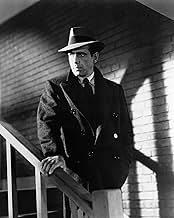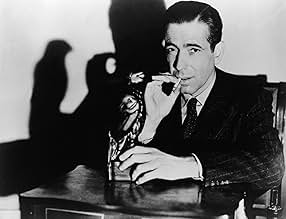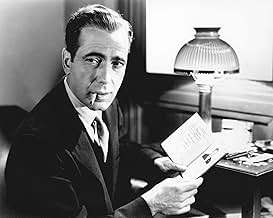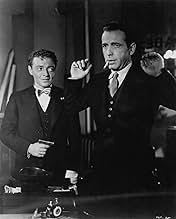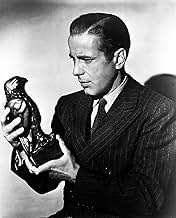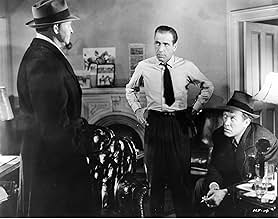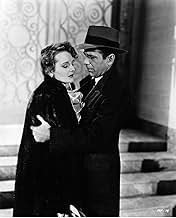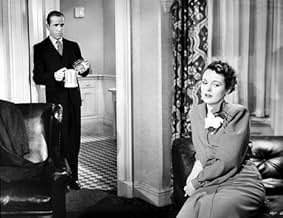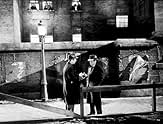Um detetive particular assume um caso que o envolve com três criminosos excêntricos, um magnífico mentiroso e sua busca por uma estatueta incomparável.Um detetive particular assume um caso que o envolve com três criminosos excêntricos, um magnífico mentiroso e sua busca por uma estatueta incomparável.Um detetive particular assume um caso que o envolve com três criminosos excêntricos, um magnífico mentiroso e sua busca por uma estatueta incomparável.
- Direção
- Roteiristas
- Artistas
- Indicado a 3 Oscars
- 8 vitórias e 4 indicações no total
Charles Drake
- Reporter
- (não creditado)
Chester Gan
- Bit Part
- (não creditado)
Creighton Hale
- Stenographer
- (não creditado)
Robert Homans
- Policeman
- (não creditado)
William Hopper
- Reporter
- (não creditado)
- Direção
- Roteiristas
- Elenco e equipe completos
- Produção, bilheteria e muito mais no IMDbPro
Avaliações em destaque
Seven decades have passed but the suspense and thrill of The Maltese Falcon still reign supreme. The movie, despite being in black & white, appears strikingly refreshing both to the eyes and the intellect. Primarily remembered as John Huston's directorial debut, the movie played a decisive role in giving Film-Noire its true identity as a genre. The Maltese Falcon also gave Humphrey Bogart his highly deserved super-stardom that had hitherto eluded him. Huston creates an environment of suspicion, doubt and uncertainty that is so convoluted that even Hitchcock would be proud of it. The movie has multiple layers of mystery and suspense that keeps the viewer engaged throughout.
Sam Spade is a private detective who runs an agency with his partner Miles Archer. An ostensibly naive lady, Miss Wanderly offers them a task to pursue a man, Floyd Thursby, who has allegedly run off with her younger sister. The over-simplicity of task arouses Spade's suspicion, but Wanderly's lucrative offer makes the duo overlook it initially. Miles is killed during the pursuit and the police inform Spade of the mishap. Spade only discreetly tells the police that Miles was after a man named Thursby without disclosing anything about Miss Wandely. The police soon find Thursby dead as well and suspect Spade for killing him in an act of revenge. Soon Miles Archer's widow shows up at Spade's office and insinuates of her romantic involvement with Spade, who shuns her away after she tries to incriminate him for the murder. The police come across an anonymous lead and begin suspecting Spade for killing his partner, Miles. The plot thickens with the entry a couple of obscure characters including Joel Cairo, who happens be an acquaintance of Miss Wanderly. He is in pursuit of a highly precious, antique, gold statuette of Maltese Falcon and offers Spade five grands to help him find it. A game of cat and mouse soon ensues, between the various stake holders, which becomes deadlier as the stakes are raised.
Humphrey Bogart perfectly fits into the shoes of Spade—a sleek and sharp sleuth—and makes it his own in a manner that only someone of his grit and caliber could. Bogart is in top form right from the inception to the finale, stealing the spotlight in almost every scene that is he is part of. Bogart could only demonstrate his prodigious talent and acting prowess in short bursts during his long "B movie" stint in which he was mostly type-casted as a gangster. The Maltese Falcon was Bogart's big break after years of anticipation and he didn't leave a single stone unturned to prove his mettle. Bogart shows his class and stamps his authority as a performer during the portrayal of Spade: he is ever so quick-witted thanks to his sublime articulacy and his prowess at repartee seems unparalleled; the inherent cynicism in Spade and the perspicacity with which he operates soon became Bogart's trademark and catapulted him to super-stardom. Many regard Bogart's performance in Casablanca as his absolute best, but I rate his portrayal of Spade second only to his supernal portrayal of Dobbs in The Treasure of Sierre Madre, where he took acting to hitherto unattainable and unforeseeable heights.
John Huston uses the Midas touch he had as a screenwriter to strike all the right cords in his directorial debut. Almost everyone in the supporting cast gives a memorable performance with special mention of Peter Lorre as the deceptive Joel Cairo, Sydney Greenstreet as the witty yet dangerous Kasper Gutman and Mary Astor as the scheming Brigid O' Shaughnessy. The taut plot of the movie, which is masterfully adapted from the novel of the same name by Huston himself, is well complemented by the impressively written dialogs that are delivered with an equal prowess. Amidst the everlasting suspense the movie has an obvious undertone of dark humor that adds great value to the movie. The cinematography undoubtedly features amongst the best works of the time.
The Maltese Falcon is not merely a Noire masterpiece but also a testament to the true spirit of cinema that has kept itself alive despite decades of relentless mutilation and sabotage in the name of commercial movie-making. Despite being devoid of modern-day gimmicks the movie is incredibly high on suspense and holds the viewer in a vice-like grip throughout its runtime. It's a real shame that movies like these are seldom made these days. The tone of the movie is such that it makes suspense thrillers of today appear like kids cartoon.
PS. The movie is an ode to Bogart, Huston and all those who made it a reality. It's suspense cinema at its absolute best with a completely different treatment to themes propagated by the likes of Hitchcock. It's a must for all the Bogart fans worldwide, and absolutely essential for all those who have a penchant for Film-Noire as a genre. 10/10
http://www.apotpourriofvestiges.com/
Sam Spade is a private detective who runs an agency with his partner Miles Archer. An ostensibly naive lady, Miss Wanderly offers them a task to pursue a man, Floyd Thursby, who has allegedly run off with her younger sister. The over-simplicity of task arouses Spade's suspicion, but Wanderly's lucrative offer makes the duo overlook it initially. Miles is killed during the pursuit and the police inform Spade of the mishap. Spade only discreetly tells the police that Miles was after a man named Thursby without disclosing anything about Miss Wandely. The police soon find Thursby dead as well and suspect Spade for killing him in an act of revenge. Soon Miles Archer's widow shows up at Spade's office and insinuates of her romantic involvement with Spade, who shuns her away after she tries to incriminate him for the murder. The police come across an anonymous lead and begin suspecting Spade for killing his partner, Miles. The plot thickens with the entry a couple of obscure characters including Joel Cairo, who happens be an acquaintance of Miss Wanderly. He is in pursuit of a highly precious, antique, gold statuette of Maltese Falcon and offers Spade five grands to help him find it. A game of cat and mouse soon ensues, between the various stake holders, which becomes deadlier as the stakes are raised.
Humphrey Bogart perfectly fits into the shoes of Spade—a sleek and sharp sleuth—and makes it his own in a manner that only someone of his grit and caliber could. Bogart is in top form right from the inception to the finale, stealing the spotlight in almost every scene that is he is part of. Bogart could only demonstrate his prodigious talent and acting prowess in short bursts during his long "B movie" stint in which he was mostly type-casted as a gangster. The Maltese Falcon was Bogart's big break after years of anticipation and he didn't leave a single stone unturned to prove his mettle. Bogart shows his class and stamps his authority as a performer during the portrayal of Spade: he is ever so quick-witted thanks to his sublime articulacy and his prowess at repartee seems unparalleled; the inherent cynicism in Spade and the perspicacity with which he operates soon became Bogart's trademark and catapulted him to super-stardom. Many regard Bogart's performance in Casablanca as his absolute best, but I rate his portrayal of Spade second only to his supernal portrayal of Dobbs in The Treasure of Sierre Madre, where he took acting to hitherto unattainable and unforeseeable heights.
John Huston uses the Midas touch he had as a screenwriter to strike all the right cords in his directorial debut. Almost everyone in the supporting cast gives a memorable performance with special mention of Peter Lorre as the deceptive Joel Cairo, Sydney Greenstreet as the witty yet dangerous Kasper Gutman and Mary Astor as the scheming Brigid O' Shaughnessy. The taut plot of the movie, which is masterfully adapted from the novel of the same name by Huston himself, is well complemented by the impressively written dialogs that are delivered with an equal prowess. Amidst the everlasting suspense the movie has an obvious undertone of dark humor that adds great value to the movie. The cinematography undoubtedly features amongst the best works of the time.
The Maltese Falcon is not merely a Noire masterpiece but also a testament to the true spirit of cinema that has kept itself alive despite decades of relentless mutilation and sabotage in the name of commercial movie-making. Despite being devoid of modern-day gimmicks the movie is incredibly high on suspense and holds the viewer in a vice-like grip throughout its runtime. It's a real shame that movies like these are seldom made these days. The tone of the movie is such that it makes suspense thrillers of today appear like kids cartoon.
PS. The movie is an ode to Bogart, Huston and all those who made it a reality. It's suspense cinema at its absolute best with a completely different treatment to themes propagated by the likes of Hitchcock. It's a must for all the Bogart fans worldwide, and absolutely essential for all those who have a penchant for Film-Noire as a genre. 10/10
http://www.apotpourriofvestiges.com/
Not only is "The Maltese Falcon" one of the first prototypical examples in what would be the subsequent 10 years of great film noir movies, it's also the first movie in the exemplary directing career of John Huston (from the screenplay he adapted from Dashiell Hammett's Sam Spade novel). And, even though Bogart had been acting throughout the '30s in mostly supporting roles opposite great actors (like Edward G. Robinson, James Cagney, etc.) and actresses (Bette Davis, Ida Lupino, Ann Sheridan, etc.), this role was to make him a bankable star & lead.
Like many films in the noir genre, the unnecessarily complicated plot devices are secondary to lighting, mood, tone, and the imperfect cast of characters. It's not as absolutely inscrutable as "The Big Sleep," but more or less tied with "Out of the Past" on the hard to follow scale. Mary Astor was an old pro by this time, and she'd said that the motion picture newbie, Sydney Greenstreet, was scared to death during his scenes, though you'd certainly never know it from the result.
Huston managed to find a little cameo appearance for his father, Walter Huston as the mysterious Captain Jacoby. And the matte black statuette of the title is perhaps the ultimate example of what Hitchcock called the "MacGuffin," and as Bogart tells his cop friend at the end: "It's what dreams are made of." Indeed.
Like many films in the noir genre, the unnecessarily complicated plot devices are secondary to lighting, mood, tone, and the imperfect cast of characters. It's not as absolutely inscrutable as "The Big Sleep," but more or less tied with "Out of the Past" on the hard to follow scale. Mary Astor was an old pro by this time, and she'd said that the motion picture newbie, Sydney Greenstreet, was scared to death during his scenes, though you'd certainly never know it from the result.
Huston managed to find a little cameo appearance for his father, Walter Huston as the mysterious Captain Jacoby. And the matte black statuette of the title is perhaps the ultimate example of what Hitchcock called the "MacGuffin," and as Bogart tells his cop friend at the end: "It's what dreams are made of." Indeed.
Sam Spade and Miles Archer are detectives, the private type who you can give directives, after meeting with a dame, there then begins a deadly game, with a group who seem to have, their own perspectives; although they all have as their goal a missing falcon, and soon there are some folks, who find their souls gone, as beneath the dark veneer, there are those quite insincere, as you'll find after a number of liaisons; as the story ratchets up the threads combine, and at the centre of the plot's a large waistline, that speaks with eloquence and intent, as deep within, passions ferment, in a film that is a classic of its time.
Great cast, great story, great film - but isn't Sydney Greenstreet outstanding!
Great cast, great story, great film - but isn't Sydney Greenstreet outstanding!
Considered by many film historians as the very first noir film, "The Maltese Falcon" is cinematically important also for making Humphrey Bogart into a Hollywood star, and for being the debut of John Huston as film Director.
The film's story is complex and convoluted, typical of detective films of that era, and involves a valuable statuette. The plot stalls and meanders throughout most of the film, as we encounter an assortment of strange characters and side issues. But this is not a plot-driven film. It is character-driven.
And the main character, of course, is PI Sam Spade (Bogart). He's not a particularly nice guy. He comes across as overconfident and egotistic. He smirks a lot. But he's tough as nails. And he knows how to nail the bad guys. A big part of the film is Spade's relationship to femme fatale Brigid (Mary Astor). They engage each other in a battle of wits. And there's more than a hint of romantic involvement between the two. But Brigid is the one who propels Spade into the deceiving and double-crossing world of bad guys who yearn with greed for the priceless Maltese Falcon.
Enter Kasper Gutman, that thoroughly rotund and intimidating (in a gentlemanly sort of way) king of greed, portrayed with verve and panache by the inimitable Sydney Greenstreet. Gutman, AKA the "Fat Man", is nothing if not erudite and self-assured. In one scene, Sam Spade makes a bold offer. Gutman responds articulately: "That's an attitude sir that calls for the most delicate judgment on both sides, because as you know sir, in the heat of action, men are likely to forget where their best interests lie ...".
And Peter Lorre is a hoot as Gutman's mischievous elf, Joel Cairo, who tries, without success, to threaten Sam Spade, but only succeeds at getting on Sam's nerves.
The film's high contrast B&W lighting renders an effective noir look and feel, one that would be copied in films for years to come. Acting varies from very good to overly melodramatic. The script is very talky. For the most part, the film is just a series of conversations that take place in interior sets.
Stylistic and cinematically innovative, "The Maltese Falcon" has endured as a film classic. I suspect the main reason for its continued popularity is the continued popularity of Bogart. But I personally prefer the performance of Sydney Greenstreet, the enticing fat man. Yet, together they would reappear in later films, one of which would follow, in 1942, as the classic of all classics.
The film's story is complex and convoluted, typical of detective films of that era, and involves a valuable statuette. The plot stalls and meanders throughout most of the film, as we encounter an assortment of strange characters and side issues. But this is not a plot-driven film. It is character-driven.
And the main character, of course, is PI Sam Spade (Bogart). He's not a particularly nice guy. He comes across as overconfident and egotistic. He smirks a lot. But he's tough as nails. And he knows how to nail the bad guys. A big part of the film is Spade's relationship to femme fatale Brigid (Mary Astor). They engage each other in a battle of wits. And there's more than a hint of romantic involvement between the two. But Brigid is the one who propels Spade into the deceiving and double-crossing world of bad guys who yearn with greed for the priceless Maltese Falcon.
Enter Kasper Gutman, that thoroughly rotund and intimidating (in a gentlemanly sort of way) king of greed, portrayed with verve and panache by the inimitable Sydney Greenstreet. Gutman, AKA the "Fat Man", is nothing if not erudite and self-assured. In one scene, Sam Spade makes a bold offer. Gutman responds articulately: "That's an attitude sir that calls for the most delicate judgment on both sides, because as you know sir, in the heat of action, men are likely to forget where their best interests lie ...".
And Peter Lorre is a hoot as Gutman's mischievous elf, Joel Cairo, who tries, without success, to threaten Sam Spade, but only succeeds at getting on Sam's nerves.
The film's high contrast B&W lighting renders an effective noir look and feel, one that would be copied in films for years to come. Acting varies from very good to overly melodramatic. The script is very talky. For the most part, the film is just a series of conversations that take place in interior sets.
Stylistic and cinematically innovative, "The Maltese Falcon" has endured as a film classic. I suspect the main reason for its continued popularity is the continued popularity of Bogart. But I personally prefer the performance of Sydney Greenstreet, the enticing fat man. Yet, together they would reappear in later films, one of which would follow, in 1942, as the classic of all classics.
"The Maltese Falcon", scripted and directed by Hollywood first-timer John Huston (from Dashiell Hammett's novel), would go on to become an American film classic. Humphrey Bogart chews the scenery in his star-making turn as acid-tongued private eye Sam Spade, whose association with the beautiful and aloof Brigid O'Shaughnessy (Mary Astor), neurotic Joel Cairo (Peter Lorre), and morbidly obese Kasper Gutman (Sydney Greenstreet, in his Oscar-nominated screen debut) over the recovery of the title object, sets in motion a movie experience that is as much crackling as it is dazzling. While much of the action and dialogue is considerably dated by modern standards, the film's essential power to mystify and entrance remains undiminished despite its age. While this was the third adaptation of Hammett's story (the first was made in 1931 and the second was "Satan Met a Lady" (1936)), this is also the best remembered and most praised, due largely in part to Bogart's seemingly effortless portrayal of the tough but softhearted, world-weary hero. Mary Astor and Lee Patrick were, respectively, the definitive femme fatale and girl Friday, and the villianous roles of Cairo, Gutman and Wilmer (Elisha Cook Jr.) were equally remarkable. What may not be wholly obvious is the fact that these three men have homosexual tendencies (as given in the novel), but just look at what's given: Cairo's delicate speech and manner, Wilmer's questionable quick tempered attitude towards Spade (could this be covering up the fact that he finds Spade attractive?) and Gutman's clutching of Spade's arm when Sam arrives at his hotel room. A polished film noir that gave rise to Bogart's mounting popularity. (Sidenote: The character of Sam Spade was originally offered to George Raft, who turned it down. Raft also turned down "Casablanca" (1942), "High Sierra" (1941) and William Wyler's "Dead End" (1937), all of which went to Bogart and helped to boost his star status. Bogart had Raft to thank for his enduring popularity.) A must-see masterpiece. ****
Você sabia?
- CuriosidadesThree of the falcon statuettes made for the production still exist and are conservatively valued at over $1 million each. This makes them some of the most valuable film props ever made; indeed, each is now worth more than three times what the film cost to make.
- Erros de gravaçãoSpade doesn't wear rings or a watch throughout the movie except for one scene. At one point he walks into his office wearing a wedding band on his left hand, another large ring on his right hand and an expensive looking wristwatch. He sits down to have a quick chat with his secretary where the rings and watch are in plain view. He then walks through a doorway into his inner office and the rings and watch are gone.
- Citações
Joel Cairo: You always have a very smooth explanation ready.
Sam Spade: What do you want me to do, learn to stutter?
- Versões alternativasAlso available in a computer colorized version.
- ConexõesEdited into Contos da Cripta: You, Murderer (1995)
Principais escolhas
Faça login para avaliar e ver a lista de recomendações personalizadas
- How long is The Maltese Falcon?Fornecido pela Alexa
- Is the movie faithful to Dashiell Hammett's novel?
- What is a "gunsel"?
- Is "Maltese Falcon" the first noir film?
Detalhes
- Data de lançamento
- País de origem
- Idioma
- Também conhecido como
- Relíquia Macabra
- Locações de filme
- Bush Street, San Francisco, Califórnia, EUA(death of Miles Archer)
- Empresa de produção
- Consulte mais créditos da empresa na IMDbPro
Bilheteria
- Orçamento
- US$ 375.000 (estimativa)
- Faturamento bruto nos EUA e Canadá
- US$ 18.180
- Faturamento bruto mundial
- US$ 41.740
- Tempo de duração1 hora 40 minutos
- Cor
- Proporção
- 1.37 : 1
Contribua para esta página
Sugerir uma alteração ou adicionar conteúdo ausente




